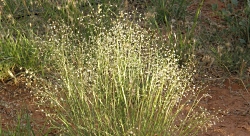Most people could probably name the state bird or the state tree, but what about the state gem? The state grass? State fruit? Do you know why they are important to Utah? Here are just a few of Utah’s State Symbols that you might not have known.

Utah’s state grass was selected in 1990 to be Indian Ricegrass. As you might suspect, indian ricegrass was given its name because of the significance in Native American life. This tough bunchgrass was a common food source and was absolutely crucial to survival when the corn crop failed. 
Courtesy US National Park Service
The cherry did not become the state fruit until 1997 when a group of second graders did their research and petitioned for the fruit to be recognized. Cherry was discovered to be the most economically beneficial fruit for Utah when compared to other fruits like peaches and apples. Both sweet and tart cherries are grown commercially in Utah. Utah is the only state ranked in the top five cherry producing states for both types of cherries. 
Courtesy USDA
The state insect might be a little easier to guess than the state grass and state fruit. Utah is known as the beehive state, so naturally our state insect is the honeybee. When settlers first arrived in Utah they called it Deseret which means honeybee. Some native bees are listed as endangered species, but many Utahns have become “backyard beekeepers” to help these bees survive. 
Courtesy NASA ClimateKids
No matter where in the state of Utah you are, you can learn more about these plants, animals, and rocks and see them in action. As a Chinese proverb says, “Learning is a treasure that will follow its owner everywhere.”
This is Aspen Flake and I am Wild About Utah.
Credits:
Photos: Courtesy US NPS and US FWS
Audio: Courtesy and Copyright Kevin Colver
Text: Aspen Flake
Additional Reading & Listening
State Symbols, as found on OnlineLibrary.Utah.gov, https://onlinelibrary.utah.gov/research/utah_symbols/
Utah as found in StateSymbolsUSA.org: https://statesymbolsusa.org/states/united-states/utah
Gorman, Steve, U.S. Lists a Bumble Bee Species as Endangered for First Time, Scientific American, A Division of Nature America, Inc., Jan 11, 2017,
https://www.scientificamerican.com/article/u-s-lists-a-bumble-bee-species-as-endangered-for-first-time/
Hrala, Josh, 7 Bee Species Have Been Added to The US Endangered Species List, ScienceAlert.com, 3 OCT 2016, https://www.sciencealert.com/seven-species-of-bees-have-been-added-to-the-endangered-species-list
Insects: Bees in trouble and agriculture decline, Endangered Species International, Inc. https://www.endangeredspeciesinternational.org/insects6.html
Ingraham, Christopher, Believe it or not, the bees are doing just fine, Washington Post, October 10, 2016
https://www.washingtonpost.com/news/wonk/wp/2016/10/10/believe-it-or-not-the-bees-are-doing-just-fine/
